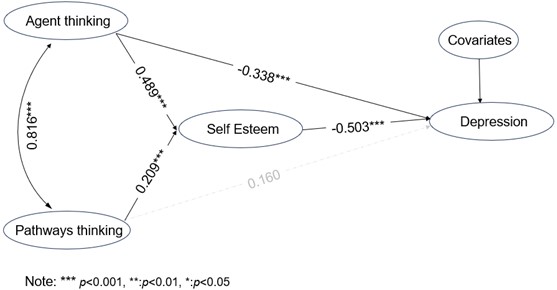The Immediate Relationship Between Hope and Depression: The Self-Esteem as a Mediator
Abstract
The concepts of hope and self-esteem in positive psychology can help people resist psychological distress. But it's not clear how they interact to protect each other. This study used a cross-sectional survey of 1185 participants to explore the role of two factors of hope and self-esteem in reducing depressed mood. The results suggest that self-esteem plays a mediating role between motivational thinking and depression. This finding reveals the intrinsic role of motivational thinking and self-esteem in protecting well-being, and has positive implications for mental health interventions such as alleviating depression.
References
Chan, S. C. Y., & Huang, Q. L. (2024). The mediating role of self‐esteem in the relationship between hope and life satisfaction among university students during a global health crisis. Health Science Reports, 7(8), e2311. https://doi.org/10.1002/hsr2.2311
Cheavens, J. S., Feldman, D. B., Gum, A., Michael, S. T., & Snyder, C. R. (2006). Hope therapy in a community sample: A pilot investigation. Social Indicators Research, 77(1), 61–78. https://doi.org/10.1007/s11205-005-5553-0
Chen, C., Shen, Y., Zhu, Y., Xiao, F., Zhang, J., & Ni, J. (2023). The effect of academic adaptability on learning burnout among college students: The mediating effect of self-esteem and the moderating effect of self-efficacy. Psychology Research and Behavior Management, 16, 1615–1629. https://doi.org/10.2147/PRBM.S408591
Dee, E. C., Mitchell, W. G., & D'Amico, A. V. (2020, December 1). Enabling hope. The Lancet Oncology, 21(12), e549. https://doi.org/10.1016/S1470-2045(20)30616-1
Doll, W. J., Xia, W., & Torkzadeh, G. (1994). A confirmatory factor analysis of the end-user computing satisfaction instrument. MIS Quarterly, 18(4), 453. https://doi.org/10.2307/249524
Donnellan, M. B., Trzesniewski, K. H., & Robins, R. W. (2011). Self‐esteem: Enduring issues and controversies. In T. Chamorro‐Premuzic, S. Von Stumm, & A. Furnham (Eds.), The Wiley‐Blackwell handbook of individual differences (1st ed., pp. 718–746). Wiley. https://doi.org/10.1002/9781444343120.ch28
Du, H., Bernardo, A. B. I., & Yeung, S. S. (2015). Locus-of-hope and life satisfaction: The mediating roles of personal self-esteem and relational self-esteem. Personality and Individual Differences, 83, 228–233. https://doi.org/10.1016/j.paid.2015.04.026
Du, H., King, R. B., & Chu, S. K. W. (2016). Hope, social support, and depression among Hong Kong youth: Personal and relational self-esteem as mediators. Psychology, Health & Medicine, 21(8), 926–931. https://doi.org/10.1080/13548506.2015.1127397
Duman, C. H. (2010). Models of depression. In Vitamins & Hormones (Vol. 82, pp. 1–21). Elsevier. https://doi.org/10.1016/S0083-6729(10)82001-1
Finney, S. J., & DiStefano, C. (2006). Non-normal and categorical data in structural equation modeling. Structural Equation Modeling: A Second Course, 10(6), 269–314.
Garaigordobil, M., Pérez, J. I., & Mozaz, M. (n.d.). Self-concept, self-esteem and psychopathological symptoms.
Germann, J. N., Leonard, D., Heath, C. L., Stewart, S. M., & Leavey, P. J. (2018). Hope as a predictor of anxiety and depressive symptoms following pediatric cancer diagnosis. Journal of Pediatric Psychology, 43(2), 152–161. https://doi.org/10.1093/jpepsy/jsx097
Greenberg, et al. (2003). The economic burden of depression with painful symptoms.
Kessler, R. C., Angermeyer, M., Anthony, J. C., Graaf, R. D., Gasquet, I., Girolamo, G. D., Gluzman, S., Gureje, O., Haro, J. M., Kawakami, N., Karam, A., Levinson, D., Medina, M. E., Browne, M. A. O., Posada-Villa, J., Stein, D. J., Tsang, C. H. A., Aguilar-Gaxiola, S., Alonso, J., … Üstün, T. B. (2007). Lifetime prevalence and age-of-onset distributions of mental disorders in the World Health Organization’s World Mental Health Survey Initiative. World Psychiatry.
Lovibond, P. F., & Lovibond, S. H. (1995). The structure of negative emotional states: Comparison of the Depression Anxiety Stress Scales (DASS) with the Beck Depression and Anxiety Inventories. Behaviour Research and Therapy, 33(3), 335–343. https://doi.org/10.1016/0005-7967(94)00075-U
Mashiach-Eizenberg, M., Hasson-Ohayon, I., Yanos, P. T., Lysaker, P. H., & Roe, D. (2013). Internalized stigma and quality of life among persons with severe mental illness: The mediating roles of self-esteem and hope. Psychiatry Research, 208(1), 15–20. https://doi.org/10.1016/j.psychres.2013.03.013
Orth, U., & Robins, R. W. (2013). Understanding the link between low self-esteem and depression. Current Directions in Psychological Science, 22(6), 455–460. https://doi.org/10.1177/0963721413492763
Orth, U., & Robins, R. W. (2014). The development of self-esteem. Current Directions in Psychological Science, 23(5), 381–387. https://doi.org/10.1177/0963721414547414
Orth, U., & Robins, R. W. (2022). Is high self-esteem beneficial? Revisiting a classic question. American Psychologist, 77(1), 5–17. https://doi.org/10.1037/amp0000922
Orth, U., Robins, R. W., & Meier, L. L. (2009). Disentangling the effects of low self-esteem and stressful events on depression: Findings from three longitudinal studies. Journal of Personality and Social Psychology, 97(2), 307–321. https://doi.org/10.1037/a0015645
Paykel, E. S. (2008). Basic concepts of depression. Dialogues in Clinical Neuroscience, 10(3), 279–289. https://doi.org/10.31887/DCNS.2008.10.3/espaykel
Reichard, R. J., Avey, J. B., Lopez, S., & Dollwet, M. (2013a). Having the will and finding the way: A review and meta-analysis of hope at work. The Journal of Positive Psychology, 8(4), 292–304. https://doi.org/10.1080/17439760.2013.800903
Reichard, R. J., Avey, J. B., Lopez, S., & Dollwet, M. (2013b). Having the will and finding the way: A review and meta-analysis of hope at work. The Journal of Positive Psychology, 8(4), 292–304. https://doi.org/10.1080/17439760.2013.800903
Reitz, A. K. (2022). Self‐esteem development and life events: A review and integrative process framework. Social and Personality Psychology Compass, 16(11), e12709. https://doi.org/10.1111/spc3.12709
Ritschel, L. A., & Cassiello-Robbins, C. (2023). Hope and depression and personality disorders. Current Opinion in Psychology, 49, 101507. https://doi.org/10.1016/j.copsyc.2022.101507
Rosenberg Self-Esteem Scale (Rosenberg, 1965). (n.d.). https://doi.org/10.1037/t01038-000
Snyder, C. R. (2002). Target article: Hope theory: Rainbows in the mind. Psychological Inquiry, 13(4), 249–275. https://doi.org/10.1207/S15327965PLI1304_01
Snyder, C. R., Harris, C., Anderson, J. R., Holleran, S. A., Irving, L. M., & Sigmon, S. X. (n.d.). The will and the ways: Development and validation of an individual-differences measure of hope.
Weber, E., Hopwood, C. J., Nissen, A. T., & Bleidorn, W. (2023). Disentangling self-concept clarity and self-esteem in young adults. Journal of Personality and Social Psychology, 125(6), 1420–1441. https://doi.org/10.1037/pspp0000460
Wen, Y., & Wu, D. X. (2012). Psychometric properties of the Chinese short version of Depression Anxiety and Stress Scale in Chinese adults. Chinese Journal of Public Health, 28(11), 1436–1438.


This work is licensed under a Creative Commons Attribution 4.0 International License.
Copyright for this article is retained by the author(s), with first publication rights granted to the journal.
This is an open-access article distributed under the terms and conditions of the Creative Commons Attribution license (http://creativecommons.org/licenses/by/4.0/).









1.png)














